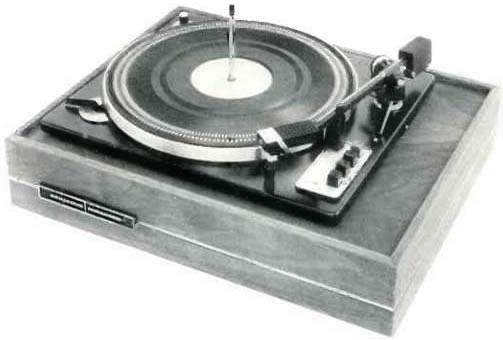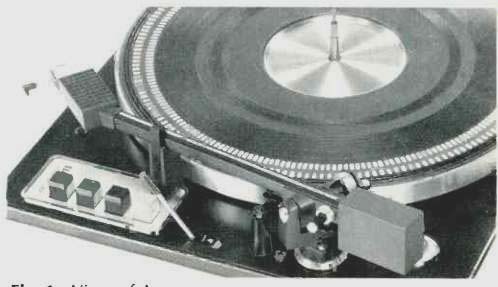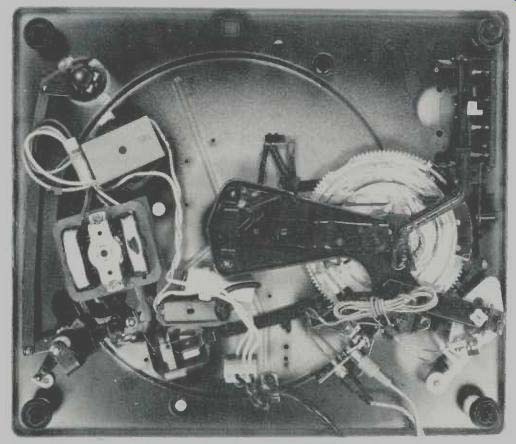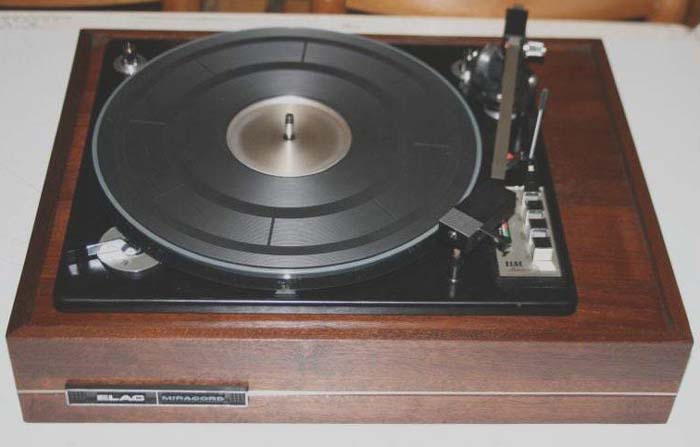
MANUFACTURER'S SPECIFICATIONS:
Speeds: 33 1/3, 45, and 78 rpm.
Wow and Flutter: 0.06%, and 0.07%, respectively.
Rumble: -44 dB.
Variable Speed: ± 3% of nominal.
Dimensions: 14 1/2 in. W. x 12 1/2 in. D.; base, 18 1/2 in. W. x 14 1/2 in. D.
Price: $199.95.

Fig. 1--View of Arm mount.
The Miracord 760 is an updated but less expensive version of the Model 50HII which we reviewed in May, 1972. It costs $199.95, as compared to $249.95 for the 50HII. Surprisingly, there are few differences, and those are minor. There are strobe rings on the turntable instead of a neon-lit window, no stylus brush is included, and the turntable platter does not have the beveled edge of the 50HII and that's about all. Everything else, motor, changing mechanism, and arm, are the same or nearly so, and the two models even look alike:
On the right are three black pushbuttons for 7-, 10-, and 12 in. records, and a fourth button, a red one, activates the Stop switch. At the left front is a three-position speed change switch, and the variable speed control is behind that at the rear corner. An anti-skating control, calibrated for 1 to 6 grams, is at the right rear near the tone arm pivot.
The arm is counterbalanced, and its weight has a milled plastic strip that meshes with the extension of a small control knob (see Fig. 2). Adjustment is simplicity itself. All you do is turn the knob until the arm (with cartridge attached) is balanced, then turn the control on the pressure dial (to the left of the pivot) to read 2 grams or whatever figure is recommended by the cartridge maker. The anti-skating knob is then set to the same figure. The plug-in head will take most cartridges, and the metal mounting insert is adjustable for quick, easy alignment. In front of the arm pivot is a long cuing lever whose lifting height and lowering time are adjustable. A silicone-filled dashpot provides nice, slow lowering of the arm. The platter is quite heavy, weighing a bit more than 6 1/4 lbs. There are two strobe scales, one for 60 Hz and the other for 50 Hz.

Fig. 2--View underneath the turntable.
As with the 50HII and other Miracords, the 760 has two spindles: a short one for single play and a "Magic Wand" for automatic play of up to 10 records. If the short spindle is inserted upside down the record will play continuously, a diversion that will probably have limited appeal, though it's certainly useful for test engineers! The long spindle holds the record on three small supports which drop each record very gently. The silicone-damped mechanism of the arm insures that the fragile (and expensive) phono stylus is not damaged as it lands on the record. The motor is a 4-pole asynchronous type which keeps the speed constant. Drive is applied to the inside of the turntable rim by a rubber idler wheel.

Two phono cartridges were used for the tests: a Shure V15-III, and an Audio-Technica AT20, a top-of-the-line CD-4 pickup. The first measurements were for wow and flutter, and the figures came out 0.05% and 0.06% respectively, slightly better than the specified 0.06% and 0.07%. The rumble measurement was -54 dB (ARRL), also excellent for a machine in this price range and notably better than the maker's claim. Tone arm resonance measured with the Shure cartridge was approximately 7 Hz, well below the critical region. As expected, the speed remained stable over the range from 90 to 130 volts. The variable speed control gave its specified variation of plus and minus 3%. The stylus pressure scale is calibrated in grams from 0 to 6, and it was found accurate within 5% above one gram. Arm tracking error was about 0.5 degrees at the worst position.
The force needed to trigger the changing mechanism was less than 0.5 grams, a far cry from the cumbersome old built like-a-battleship models of 20 years ago that used to need ounces to start the cycling sequence. The arm's friction was quite difficult to measure, being below 25 milligrams.
Cycling time was 16 seconds, a little slower than some other changers but not judged a disadvantage because the records and pickup are handled so gently. The cuing control worked smoothly and with precision, a pleasure to use. Special low-capacity cables are recommended for use with CD-4 cartridges; those supplied plug into sockets underneath so changing them is an easy matter. In order to see the strobe markings clearly the unit has to be placed near a fluorescent light; no doubt some ingenious souls will mount a small neon lamp nearby.
Summing up, the Model 50HII is still an excellent record changer at $249.95, but at a saving of $50, the 760 is a real bargain.
--George W. Tillet
(Audio magazine, Aug. 1975 )
Also see:
Elpa Model PE-2018 Automatic Turntable (Jan. 1970)
Garrard Model GT55 Automatic Turntable (April 1977)
= = = =